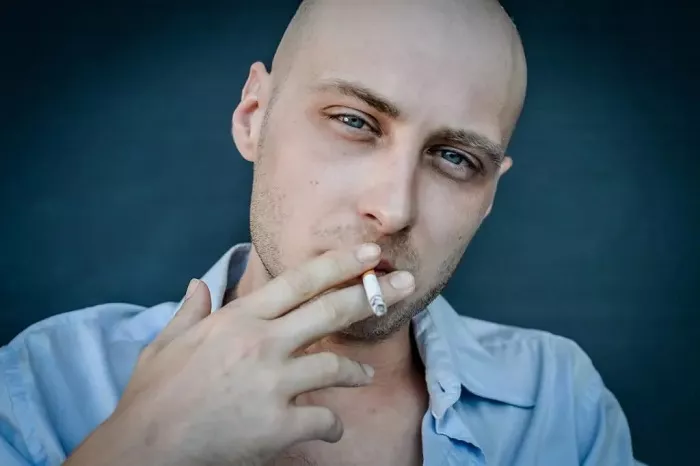Smoking is a well – known health hazard that affects various systems in the body, including the hair follicles. Hair loss associated with smoking has become a concern for many smokers. The good news is that in some cases, the negative effects of smoking on hair can be reversed. However, understanding the mechanisms behind smoking – induced hair loss and the factors influencing reversal is crucial. In this article, we will explore this topic in depth.
The Link between Smoking and Hair Loss
Effects on Blood Circulation
Smoking has a significant impact on blood vessels. The toxins in cigarette smoke cause the blood vessels to constrict. When it comes to the scalp, reduced blood flow means that the hair follicles receive less oxygen and essential nutrients. Hair follicles rely on a steady supply of blood to function properly. With decreased circulation, the follicles may become weakened and enter a resting phase prematurely. This can lead to hair thinning and eventual hair loss.
Nicotine, a major component of cigarettes, is particularly harmful in this regard. It not only constricts blood vessels but also affects the body’s hormonal balance. Hormonal changes can further disrupt the normal hair growth cycle.
Oxidative Stress and Inflammation
Cigarette smoke contains numerous free radicals that cause oxidative stress in the body. On the scalp, this oxidative stress can damage the cells of the hair follicles. The hair follicle structure can be compromised, affecting the quality of hair produced and potentially leading to hair breakage.
Additionally, smoking triggers an inflammatory response in the body. Inflammation around the hair follicles can interfere with the normal hair growth process. It can disrupt the communication between the follicle cells and lead to abnormal hair growth patterns or hair loss.
Can the Damage Be Reversed?
Quitting Smoking
The most important step in reversing hair loss caused by smoking is to quit smoking. Once a person stops smoking, the body begins to repair itself. Blood vessels gradually start to dilate, improving blood circulation to the scalp. Over time, this can restore the supply of oxygen and nutrients to the hair follicles.
The recovery process may not be immediate. It can take weeks to months for the body to fully recover from the effects of smoking.
However, within a few weeks of quitting, there may be some initial improvements in blood flow. As the blood vessels heal and function better, the hair follicles can start to recover.
Lifestyle Changes
Diet: A healthy diet rich in antioxidants can help combat the oxidative stress caused by smoking. Include plenty of fruits and vegetables such as berries, spinach, and oranges. These are high in vitamins C and E, which are powerful antioxidants.
Antioxidants can neutralize the free radicals in the body, reducing the damage to the hair follicles. Additionally, foods rich in protein like lean meats, fish, and beans are essential for hair growth. Protein provides the building blocks for the hair shaft.
Exercise: Regular physical activity improves overall blood circulation. Engaging in aerobic exercises like running, swimming, or cycling can enhance blood flow throughout the body, including the scalp. Exercise also helps to reduce stress, which can be a contributing factor to hair loss. When the body is under stress, it can disrupt the hair growth cycle. By managing stress through exercise, you can support the recovery of your hair.
Hair Care Routine
Gentle Shampooing: Use a mild, sulfate – free shampoo. Harsh shampoos can strip the hair of its natural oils, especially when the hair follicles are already weakened. Gently massage the shampoo into the scalp to stimulate blood flow without causing excessive trauma to the follicles.
Conditioning: A good conditioner can help to keep the hair moisturized and prevent breakage. Focus on the ends of the hair, which are often the driest. When the hair is in better condition, it can support the regrowth process.
Avoiding Heat and Chemicals: Minimize the use of heat – styling tools such as flat irons and blow dryers. High heat can further damage the hair. Also, avoid chemical treatments like hair dyes and relaxers if possible. These can add to the stress on the already compromised hair follicles.
Timeframe for Hair Regrowth
Initial Signs of Improvement
In the first few months after quitting smoking, you may notice that your hair feels less brittle. This is because the improvement in blood circulation and reduction in oxidative stress start to have an effect on the hair shaft. The hair may also appear shinier as the follicles are better nourished.
Some people may start to see a reduction in hair fall within a few weeks. This is a positive sign that the hair follicles are starting to recover. However, it’s important to note that individual responses can vary.
Long – Term Regrowth
Over the course of several months to a year, significant hair regrowth can occur. The new hair may initially be fine and thin, but as the follicles continue to recover, it will become thicker and stronger. It can take up to a year or more for the hair to fully regain its pre – smoking quality and density in some cases. This depends on factors such as the duration and intensity of smoking, as well as the overall health of the individual.
Conclusion
Hair loss from smoking can be reversed to a large extent through a combination of quitting smoking, making positive lifestyle changes, and maintaining a good hair care routine. While the process may be gradual and require patience, the potential for hair regrowth is significant. It’s important to remember that taking care of your overall health is key to restoring the health of your hair. If you are concerned about hair loss, consulting a dermatologist or a hair specialist can provide additional guidance and support throughout the recovery process.

